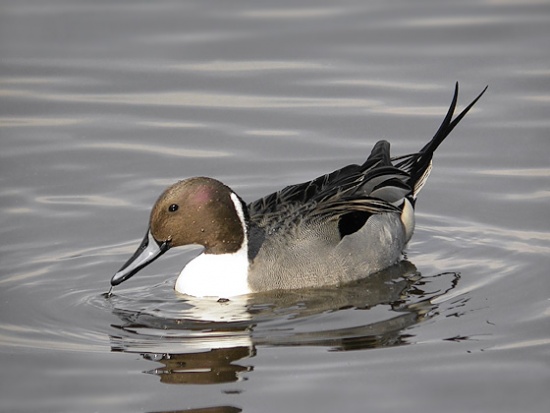- Anas acuta
Identification

Keoladeo National Park, Bharatpur, India, Dec-2015
Photo © by Alok Tewari
65 to 75 cm (25½-29½ in) in length, while females are smaller at 50 to 55 cm (19¾-21¾ in).
Male
- Pale grey bill with black stripe down centre
- Dark brown head
- White neck, breast and belly
- White finger extending up back of neck to rear part of face
- Grey flanks and back with black centres to back feathers
- Whitish patch at rear portion of flanks bordering undertail coverts
- Black undertail coverts
- Long, black central tail feathers
- Green speculum
- White rear border and chestnut forward border
Female is mostly brown, richer brown on head with bold buff mottling on mantle and strong white mottling below. Tail still pointed, but shorter than male.
Similar Species
- Female may be confused with female Mallard, but has all dark bill without orange and thinner more graceful body shape. It also lacks the blue speculum and orange legs of the Mallard.
Distribution
Iceland, Northern Europe, Russia, China, North America, and Canada. Common on most lakes.
Taxonomy
This is a monotypic species[1].
Isolated southern populations of pintails from Kerguelen (eatoni) and the Crozet Islands (drygalskii) are treated either as subspecies of Northern Pintail or as full species by some authorities[2].
Habitat
Breeds on freshwaters including flooded meadows, well-vegetated lakes or slow-flowing rivers.
Behaviour
Diet
It feeds by dabbling for plant food mainly in the evening or at night. Diet includes aquatic insects, mollusks and crustaceans as well as grasses and seeds in fields.
Breeding
The nest is a shallow scrape on the ground lined with plant material and down, in a dry location that may be fairly far from water.
Vocalisation
References
- Clements, J. F., T. S. Schulenberg, M. J. Iliff, D. Roberson, T. A. Fredericks, B. L. Sullivan, and C. L. Wood. 2018. The eBird/Clements checklist of birds of the world: v2018. Downloaded from http://www.birds.cornell.edu/clementschecklist/download/
- Avibase
- Carboneras, C. & Kirwan, G.M. (2019). Northern Pintail (Anas acuta). In: del Hoyo, J., Elliott, A., Sargatal, J., Christie, D.A. & de Juana, E. (eds.). Handbook of the Birds of the World Alive. Lynx Edicions, Barcelona. (retrieved from https://www.hbw.com/node/52884 on 30 March 2019).
- Clark, R. G., J. P. Fleskes, K. L. Guyn, D. A. Haukos, J. E. Austin, and M. R. Miller (2014). Northern Pintail (Anas acuta), version 2.0. In The Birds of North America (A. F. Poole, Editor). Cornell Lab of Ornithology, Ithaca, NY, USA. https://doi.org/10.2173/bna.163
Recommended Citation
- BirdForum Opus contributors. (2024) Northern Pintail. In: BirdForum, the forum for wild birds and birding. Retrieved 22 December 2024 from https://www.birdforum.net/opus/Northern_Pintail
External Links
GSearch checked for 2020 platform.





